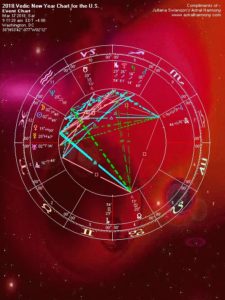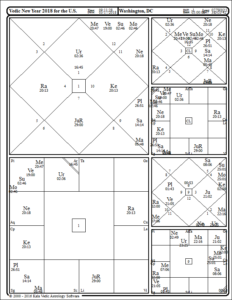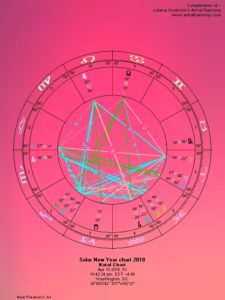One of the many New Year charts used in Vedic astrology is based on the New Moon in Pisces, when the Sun and Moon come together in the same celestial longitude (conjunction) in Pisces constellation in the pratipada tithi. This is called Chaitra Shukla Pratipada, the first synodic lunar day (tithi) of the waxing Moon in the Vedic month of Chaitra. It is believed that Lord Brahma created the universe on this very day. In this year of 2018, Chaitra Shukla Pratipada tithi starts right after 9:11:28 AM on Saturday March 17 for the U.S., set for the capital of Washington D.C. The horoscope for the Vedic New Year for the U.S. is calculated for this place, date, and time.
Though the New Year chart is set for March 17, the year lord is calculated for the following day on Sun-day, March 18, which is the day on which the pratipada tithi is in place at sunrise. Each country will have a different New Year chart based on the different coordinates. The beginning of the Vedic New Year also marks Vasant Navratri, the nine-night spring festival of Mother Divine when Devi Durga comes down to bless the world and her children at the beginning of the New Year.

 The samvatsara for this New Year is called Vilambi. A samvatsara is a Sanskrit term for “year.” In the Vedic system, there are 60 samvatsaras. They are described in Brihat Samhita by Sage Varahamahira in “Chapter VIII: Jupiter’s Course (Jovian years).” Each samvatsara carries a particular essence that correlates with its Sanskrit name and also is related to its group ruler.
The samvatsara for this New Year is called Vilambi. A samvatsara is a Sanskrit term for “year.” In the Vedic system, there are 60 samvatsaras. They are described in Brihat Samhita by Sage Varahamahira in “Chapter VIII: Jupiter’s Course (Jovian years).” Each samvatsara carries a particular essence that correlates with its Sanskrit name and also is related to its group ruler.
The samvatsara for 2018-2019 is the second in a group of five years ruled by the Manes, who are of two kinds: they are the children of Lord Brahma, known as the Prajapatis, who are great rishis, progenitors, and protectors of the earth, the animal kingdom, and the human race. The Manes are also known as the “Ancestors.” They inhabit their own region between the realms of humans and gods, a place known as Pitriloka. During the current five-year cycle ruled by the Manes, I feel that ancestral propitiation and healing are extremely important for all of us, perhaps more important than usual.
Sage Varahamahira says that Vilambi will bring “scanty crops and rains.” This fits with the last Vilambi year in 1958 which saw serious droughts and famines in various parts of the world including China, Japan, and Brazil. Jataka Parijata says that those born in the Vilambi year will be prosperous and generous, described as “disinterested benevolence.” Dhundiraja in Jataka Bharanam associates those born this year with greed and restlessness. We can broadly interpret these qualities to the year 2018, as well.
The Jyotisha Vedanga names Lord Surya the ruler of this year (ruler of the second of five years in the samvatsara cycle). Surya is the Sun God who is life-giver and time-giver and who represents our capacity for vision, wisdom, and will power. He is also slightly volatile, fiery, hot, and dry, which seems to reflect a theme for this coming year, especially in July and August when Mars retrogrades in sidereal Capricorn in the eclipse axis with Ketu. This year as with the last, it will be especially important to employ a skilled muhurta/elective astrologer for timing important events since Surya the time-giver rules this year.
 The last time we had a Vilambi year was 1958-59, and here are a few highlights which may mirror some trends in 2018:
The last time we had a Vilambi year was 1958-59, and here are a few highlights which may mirror some trends in 2018:
- A major financial recession in the U.S. with high unemployment (7%) while inflation was under 2%.
- Many technological developments occurred including the invention of the microchip, computer modem, and remote control. An F-104 Starfighter set a world speed record.
- NASA was created and the U.S. military predicted that satellites orbiting the Earth would make detailed maps of space.
- The Peace Symbol was created in the U.K. in preparation for the world’s first anti-nuclear demonstrations.
- The Soviet Union launched Sputnik 3, the largest satellite ever, which was commissioned to study the Earth’s atmosphere and cosmic rays.
- The Iraq Republic was established after a military coup.
- Castro’s revolutionary army began its attacks on Havana.
- The Tibetan resistance movement against rule by China received support from the U.S. CIA.
- President Dwight D. Eisenhower signed the Federal Aviation Act transferring all authority over aviation in the U.S. to the newly created Federal Aviation Agency (FAA, later renamed Federal Aviation Administration).
- Pan American World Airways started its transatlantic flights of the Boeing 707.
On or around the first day of the Lunar New Year, the new calendar (panchanga) is installed in a Hindu temple ceremony in which the year’s upcoming predictions are read aloud. This is done for a particular country, usually India where this system originated, but also the forecast is sometimes given more generally for the world at large. The temple astrologers collaborate with each other and go into great detail in their predictions, looking at the lord and minister of the year and so forth.
The lord of the year is the Sun for the U.S. chart, as the first day that pratipada tithi is in place at sunrise in near the New Year is Sun-day, and this is in addition to the samvatsara lord also being the Sun/Lord Surya. The minister is based on the Solar New Year chart when the Sun enters sidereal Aries which will occur this year on April 13, 2018 which is a Friday, so the minister of the year for the U.S. will be Venus (ruler of Friday). Overall it is auspicious for the lord of the year, the Sun in this case, to be aspected by Jupiter which is also benefic ninth lord. Yet, the aspect of afflicted Mars is somewhat inauspicious, so we have a mixed bag which is also indicated by the fact that the minister of the year Venus is a maraka lord (creating difficulty or conflict) in the twelfth house of losses, and also Venus is receiving more malefic than benefic aspects per sphuta drishti.

 We study the various New Year charts to understand the general overview of the nation and its collective karma in the coming year. I am limited in my time so was only able to look at the U.S. chart for now. I focus here on the rashi chakra “whole sign chart” rather than the house charts.
We study the various New Year charts to understand the general overview of the nation and its collective karma in the coming year. I am limited in my time so was only able to look at the U.S. chart for now. I focus here on the rashi chakra “whole sign chart” rather than the house charts.
The lagna or rising sign (ascendant) is Bharani nakshatra in sidereal Aries. This nakshatra emphasizes creative expression but also extremism in all its forms, and both Aries and Bharani also indicate some strong potential for fires; intense cultural upheaval; national and international conflict; and economic volatility. Bharani nakshatra rising may bring focus on 1) law enforcement, criminal justice, and military matters; 2) the homeless and homeless encampments; 3) agriculture; and 4) the film industry.
Mars as ruler of the chart (Aries ascendant) occupies the ninth house in sidereal Sagittarius. Mars is afflicted by conjunction with Saturn, pointing to disputes in ideological and legal matters; transportation accidents and fires; political fanaticism and increasing activity of anti-patriotic movements; and trade, shipping, and international conflicts. Materialism, greed, and corrupt moral behavior among the people will be on the rise. Higher education will continue to be strained by funding cuts, rising costs, and other complex issues including declining completion rates and the growing trend of intolerance on university and college campuses.
Pluto is the most elevated planet in the New Year chart, as it is very close to a conjunction with the MC/midheaven in late Sagittarius. This reflects the possibility of ideological zealotry and a lack of acceptance for differences leading to destructive acts. In mundane astrology, Pluto aligned with the midheaven may sometimes indicate that the nation’s leaders are acting despotic, or are unfairly accused of despotism. The government may enforce strict or punitive measures in some cases which will cause a backlash. This placement of Pluto is often considered to be an indication that the well-being of the leader of a country is in danger, or that he may be removed from office, or may be threatened in some way.
Yet, Pluto conjoined the MC in mundane astrology is also a classic placement for clandestine undertakings conducted against the interests of the people and its leaders. Perhaps the auspicious sextile aspect (3/11) from the divine guru Jupiter to Pluto and the MC is enough of a positive aspect to protect and support the leadership of the country and help it put forth its national planning endeavors. As an example, Pluto is the significator of nuclear arms and energy, and this aspect from Jupiter seems to support the North Korean disarmament efforts desired by President Trump’s administration.
Jupiter is retrograde in the seventh house in late Libra. Jupiter here is lord of the ninth house which makes him a temporal benefic for the chart, so this is quite positive. He receives more positive aspects than negative according to sphuta drishti (exact astrological aspects per Vedic astrology). Jupiter should be positive for treaties and alliances with other nations, and may enhance foreign trade and status abroad.
Jupiter also rules the twelfth house, so these adhipatis (“house rulerships” of 9 + 12) in the seventh house of foreign allies should generally support foreign relations and international cooperation. Foreign travel in and out of the U.S. as well as foreign investment in the U.S. should be at an all-time high, as well, due to Jupiter in the seventh exchanging signs with exalted Venus (second and seventh lord) in the twelfth. This combination should also prove beneficial in terms of certain results of the recent tax reform bill.
However, because of Jupiter’s twelfth-house rulership, and the fact that Jupiter is sandhi (at the end of the sign, thus somewhat weakened), both open and hidden enemies abroad are likely to continue carrying on espionage on U.S. shores. Additionally, Jupiter and Uranus are quincunx (inconjunct or shasta-ashtakam-6/8) which is an aspect for revolutionary and dramatic cultural changes as well as many fascinating and innovative creative discoveries and inventions.
Jupiter is retrograde, which makes it more beneficial according to Vedic astrology. Mantresvara (Phaladeepika) taught that a planet becomes powerful and auspicious when retrograde. According to Sage Parasara, a planet’s benefic tendencies are greater when retrograde. Saravali, a great 10th-century commentary by Kalyana Varma, says that retrograde planets are powerful. However, they can be powerful for good or bad. Retrograde benefics confer kingship, and retrograde malefics cause misery and “aimless wandering.” In this case, Jupiter is a benefic, so is powerful and beneficial. However, a retrograde planet may bring certain delays or a sense of having to “go back” to resolve something from the past. And it could indicate the possibility of a trade war (or the fear of a trade war), which the retrograde lord of ninth and twelfth houses in the seventh house can indicate according to mundane astrology.
The Moon’s South Node Ketu is in the tenth house in Capricorn, and the North Node Rahu is in the fourth house in Cancer. Rahu in the fourth can point to damaging earthquakes and storms; and, mining or agricultural calamities or those involving schools or public buildings. Exalted Venus trines Rahu, which suggests some possible advancement of science and real estate, property, and infrastructure development, especially because the wide conjunction of second lord Venus with fifth lord Sun aspected by ninth lord Jupiter forms a dhana yoga (wealth combination).
The executive branch and leader of a country are often in danger with these nodal placements in the fourth and tenth houses, but because exalted Venus is aspecting Rahu and Ketu by trine and sextile, I think the issue is that instead, there is much ongoing opposition to the leadership. Yet, the nodes in this axis do point to much political intrigue and the threat of further societal and political polarization and extremism, especially as the nodes widely square the ascendant in Bharani nakshatra. To further understand something about the nodes in Cancer and Capricorn, please refer to my article from September 2017.
The lunation (Sun-Moon conjunction) falls in the passionate and fiery Purva Bhadrapada nakshatra in the twelfth house, where it is afflicted by a square (fourth) aspect with Mars. This points to the possibility of conspiracy against the government and its leader; the rise of both violent and non-violent crime; more political scandals with incessant media coverage; ongoing concerns with both federal and state correctional systems as well as with illegal immigration; and the devastating plight of public health related to the opioid, mental health, and rural hospital crises. The Moon in the twelfth house also suggests the possibility of scandals in connection with health care, medical facilities, and charitable institutions.
Yet, the Sun and Moon are widely conjoined benefic Venus and Mercury in Pisces, pointing to many successful societal improvements. Additionally, the Sun and Moon are receiving a protective trine from their dispositor Jupiter; Jupiter is in a beneficial exchange of signs with Venus (parivartana yoga); and, Mercury’s debilitation in Pisces is somewhat cancelled by its conjunction with Venus. All of this may suggest some benefit to law enforcement; the welfare and health of the public and its various institutions; and, the well-being of children including school safety issues. Important changes are likely to transpire through the intervention of local, state, and federal governments into the functioning and management of these systems.
May the winds, the oceans, the herbs, and night and days, the mother earth, the father heaven, all vegetation, the sun, be all sweet to us…Let us follow the path of goodness for all times, like the sun and the moon moving eternally in the sky…Let us be charitable to one another…Let us not kill or be violent with one another…Let us know and appreciate the points of view of others…And let us unite.

